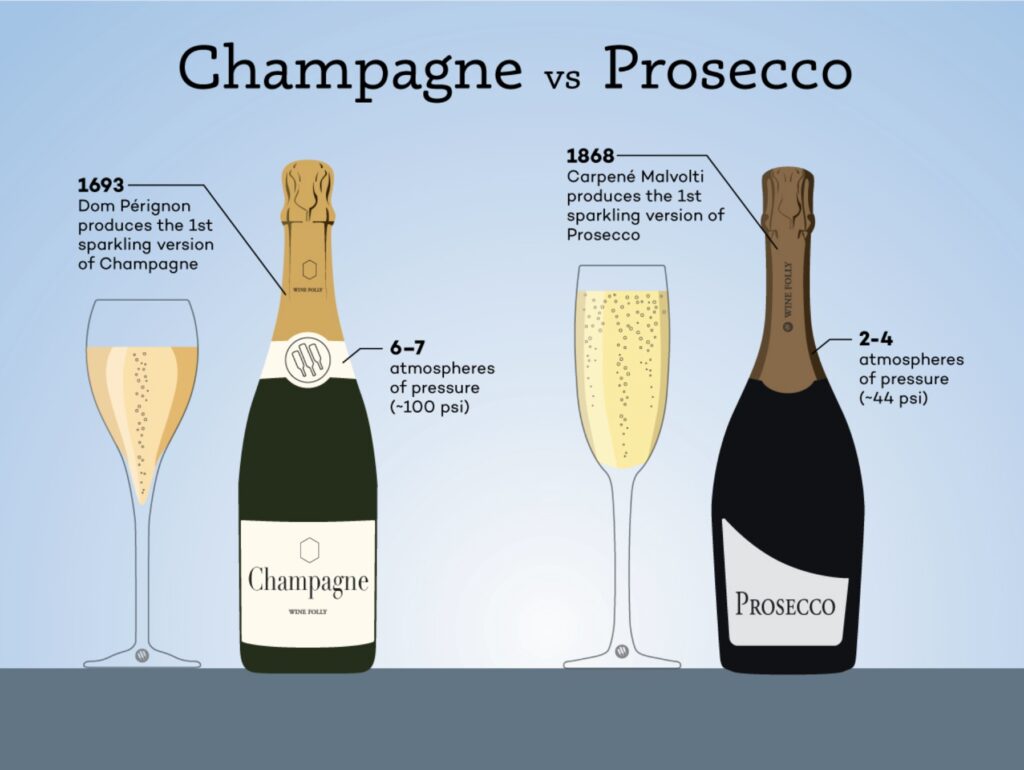When it comes to sparkling wines, Champagne and Prosecco are two of the most popular choices. While both are enjoyed worldwide for their effervescence and celebratory nature, they are distinct in terms of origin, production methods, flavor profiles, and pricing. Understanding these differences can help you choose the perfect bottle for any occasion. Let’s dive into what sets Champagne and Prosecco apart.
1. Origin: A Tale of Two Regions
The most significant difference between Champagne and Prosecco lies in their origins. Champagne comes from the Champagne region of northeastern France, which is the only area legally permitted to use the name “Champagne” for its sparkling wines. The region’s chalky soil, cool climate, and strict regulations contribute to the unique characteristics of Champagne.
Prosecco, on the other hand, hails from the Veneto and Friuli Venezia Giulia regions of northeastern Italy. The specific area of production is centered around the town of Valdobbiadene. Unlike Champagne, Prosecco’s production is less tightly regulated, allowing for a broader range of styles and price points.
2. Grape Varieties
Another key difference between these two sparkling wines is the grapes used in their production. Champagne is typically made from a blend of three main grape varieties: Chardonnay, Pinot Noir, and Pinot Meunier. These grapes contribute to the complex and nuanced flavors that Champagne is known for.
Prosecco is primarily made from the Glera grape, which is known for producing lighter, fruitier wines with floral and apple notes. Some Proseccos may include small amounts of other grapes like Verdiso, Perera, or Bianchetta, but Glera remains the dominant variety.
3. Production Methods: Traditional vs. Charmat
One of the most significant factors that differentiate Champagne from Prosecco is the method of production. Champagne is produced using the traditional method, also known as méthode champenoise. This labor-intensive process involves a second fermentation in the bottle, which creates the wine’s bubbles. After this fermentation, the wine is aged on its lees (dead yeast cells) for an extended period, contributing to its rich, toasty, and yeasty flavors.
Prosecco, however, is made using the Charmat method, also known as the tank method. In this process, the second fermentation occurs in large stainless steel tanks rather than in individual bottles. This method is quicker and less expensive than the traditional method, resulting in a wine that is generally lighter, fruitier, and less complex than Champagne.
4. Flavor Profile and Style
The differences in grape varieties and production methods lead to distinct flavor profiles in Champagne and Prosecco. Champagne tends to have a more complex and layered flavor profile, often featuring notes of citrus, green apple, brioche, and almonds. The aging process also imparts toasty and nutty nuances, making Champagne a sophisticated and versatile choice for pairing with food.
Prosecco, on the other hand, is typically lighter and more approachable, with bright flavors of apple, pear, melon, and honeysuckle. It has a slightly sweeter taste profile compared to the often drier Champagne, making it a refreshing option for casual sipping or pairing with light appetizers.
5. Price Point
Due to the labor-intensive production process and strict regulations surrounding its production, Champagne is generally more expensive than Prosecco. The cost of Champagne can vary widely, with prestige cuvées from renowned houses commanding high prices. Prosecco, thanks to its more efficient production method, is usually more affordable, making it a popular choice for everyday celebrations and gatherings.
6. Occasions and Pairings
While both Champagne and Prosecco are versatile, they shine in different settings. Champagne, with its complexity and elegance, is often reserved for special occasions, fine dining, and sophisticated pairings, such as with oysters, caviar, or rich desserts. Prosecco, with its light and fruity nature, is ideal for casual gatherings, brunches, or as an aperitif. It pairs wonderfully with light dishes like salads, seafood, and fruit-based desserts.
Conclusion: Champagne or Prosecco?
In summary, whether you choose Champagne or Prosecco depends on the occasion, your personal taste, and your budget. Champagne offers a luxurious and complex experience, perfect for celebrating life’s big moments. Prosecco provides a delightful, approachable, and budget-friendly option for more casual enjoyment. Both have their place in the world of sparkling wines, and understanding their differences allows you to appreciate each for its unique qualities.
So, the next time you’re in the mood for some bubbles, consider whether you’re craving the elegance of Champagne or the lighthearted charm of Prosecco—and enjoy the delightful journey of discovery in every sip. Cheers!
